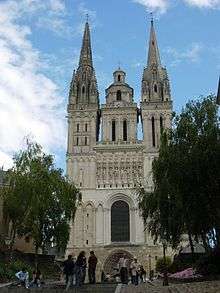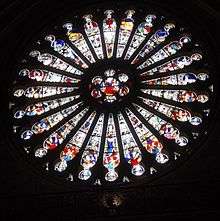Angers Cathedral
| The Saint-Maurice Cathedral of Angers Cathédrale Saint-Maurice d'Angers | |
|---|---|
 Façade of the Cathedral of Angers | |
| Basic information | |
| Location | Angers, France |
| Affiliation | Roman Catholic |
| Rite | Latin Rite |
| Municipality | Angers |
| Prefecture | Maine-et-Loire |
| Province | Diocese of Angers |
| Region | Anjou |
| Year consecrated | 1096 |
| Ecclesiastical or organizational status | Cathedral |
| Status | Active |
| Heritage designation | 1862 |
| Leadership | Renaud de Martigné and Ulger |
| Website | http://catholique-angers.cef.fr/Cathedrale-Saint-Maurice-Notre-Dame |
| Architectural description | |
| Architect(s) |
Etienne d'Azé, Jean Delespine (Towers) and Charles Joly-Leterme |
| Architectural type | Church |
| Architectural style | Romanesque, Gothic and Angevin Gothic |
| General contractor | Normand de Doué and Guillaume de Beaumont |
| Groundbreaking | 1032 |
| Completed | 1523 |
| Direction of façade | west |
| Length | 296.82 ft (90.47 m) |
| Width | 75.45 ft (23 m) |
| Width (nave) | 53.74 ft (16.38 m) |
| Height (max) | 252.6 ft (77 m) |
| Spire height |
229.6 and 252.6 ft (70 m and 77 m) |
The Saint Maurice Cathedral of Angers (French: Cathédrale Saint-Maurice d'Angers) is the seat of the Roman Catholic Diocese of Angers in France.
Built between the 11th and 16th Centuries, It was classified in 1862[1] as a national monument of France for its mixture of Romanesque and Gothic architectural styles, especially the Angevin Gothic style, and for the stained glass windows, including the transept's window of Saint Julian, considered to be a masterpiece of French 13th century glasswork.
Design

The original Romanesque church was rebuilt with Gothic details in the mid-12th century. The single-aisle plan was vaulted with pointed arches resting on a re-clad interior elevation. The nave consists of three simple bays, with single bays on either side of a crossing forming transepts, followed by a single-bay choir, backed by an apse.[2]
History
The Cathedral of Angers was originally dedicated to the Virgin Mary. But, in 396, St. Martin, the Archbishop of Tours, added St. Maurice to the dedication. He had acquired a relic of some of the blood of the members of the Theban Legion, who were martyred, along with their leader St. Maurice, in the 3rd Century for converting to Christianity. The relic was brought to Tours and later, according to legend, a phial of it was given to Angers. In the 7th Century, a devotion to St. Maurilius, the Bishop of Angers in the 4th Century, began. A biography of him was written and, in 873, his body was transferred to the Cathedral. Two hundred years, St. Maurilius and St. Maurice were frequently mentioned together as the patron saints of the Cathedral but eventually St. Maurice became the primary patron of the Cathedral.[3]
At the beginning of the eleventh century, Hubert de Vendôme, the Bishop of Angers from 1010 to 1047, wanted to build a new cathedral in the Romanesque style to replace a small and humble church. The new church was consecrated on 16 August 1025 but, seven years later, in 1032, right after the completion of the construction, it was burned to the ground.
However, Geoffroy de Tours, the Bishop of Angers from 1081 to 1093, ordered the reconstruction of the Cathedral, which continued under the supervision of his successors, Renaud de Martigné (1102–1125), Ulger (1125–1148) and Normand de Doué (1148–1153). During the rebuilding, the altar crucifix was blessed in 1051 and the new altar was consecrated in 1096.[4] The new church was finally finished in the first half of the thirteenth century, under the crosier of Guillaume de Beaumont, the Bishop of Angers from 1203 to 1240.
Consequently, the Cathedral underwent a series of changes. In the 16th Century, the gallery, featuring the knight-companions of St. Maurice, was built by Jean Delespine and the facade was added. The spire in the Renaissance style, with a hexagonal crown, was placed on the cusp of the north tower in 1518, and an identical tower was also built, in 1523, on the cusp of the south tower.[5]
During the Middle Ages, both the Angers Cathedral and the Amiens Cathedral claimed that they were in possession of the reputed head of St. John the Baptist, which had been brought to France from the Fourth Crusade but had since been lost.
In 1806, the porch, which stood in front of the facade, had to be demolished because of its dilapidated condition. Built in the Angevin Gothic style in front of the entrance's gate, it had two levels but, today, the four pointed arches are the only remaining evidence of the medieval porch. Various reconstruction projects were developed in the 20th Century but none of them made it out of the planning stage.[4]
Dimensions
- Overall length: 296.818 feet (90.47 meters)
- Width of the west facade: 75.45 feet (23 meters)
- Height of the vault of the nave: 81 feet (24.7 meters)
- Width of the nave: 53.74 feet (16.4 meters) (same as the Chartres Cathedral)
- Length of the nave: 157.48 feet (48 meters)
- Height of the two spires: 229.6 and 252.6 feet (70 and 77 meters)
The Grand Organ

The pipe organ has been in the Cathedral as early as the 14th Century. But the current incarnation was built only in 1617 by the organ maker, Jacques Girardet, who was probably recycling the pipes and other parts from the previous organ. An earlier organ was replaced in 1416 with a new case by Jean Chabencel but in 1451 it burned down, struck by a lighting bolt. A replacement was built in 1507 on the initiative of Anne of Brittany on the original spot, the counter in the choir. It was restored for the first time, after a fire, in 1533 by Peter Bert and for the second time, in 1701 by Marin Ingoult, who added the pedalboard. When Ingoult was done, the organ had, besides the pedalboard, 47 pipes with four keyboards (manuals). In the 18th Century, its case was replaced. Between 1869 and 1872, the organ was reorganized by Aristide Cavaillé-Coll. In 1957 it was electrified, adding 19 pipes for the total of 66 pipes, with just three manuals and a pedalboard. It is in the balcony of the counter at the west end of the Cathedral.
Significant Works
Among these significant works in the cathedral are:
- A set of carvings, influenced by the royal portal of the Chartres Cathedral;
- A painted wall from the 13th Century, discovered around 1980, featuring the life of St. Maurilius;
- A canopy of the life of St. Julien (located in the transept), considered a masterpiece of painted glass of the 13th Century France;
- Stained glass windows, including two rosettes of great and rich detail in the transepts, made by the master glassmaker André Robin in 1451, after a fire destroyed the windows in the north transept.[3] A number of windows were renovated in the 1960s by the master glassmaker Jacques Le Chevallier.
- The north transept of the Cathedral was paved by the architect Guillaume Robin in 1453;
- The straight staircase to the library built by Guillaume Robin, also in 1453, in the south transept. He supervised the construction of the Cathedral at the same time as the master glassmaker, André Robin, made the stained glass windows.[6]
Burials
References

- ↑ (French) Public Notice No. PA00108866 [archived], Base Mérimée [French database of national monuments], French Ministry of Culture
- ↑ (English) Klein, Bruno (2010). "The Beginnings of Gothic Architecture in France and its Neighbors". In Toman, Rolf. Gothic Architecture, Sculpture, Painting. Potsdam: H.F. Ullmann. p. 34. ISBN 978-3-8331-1038-2.
- 1 2 (English) David King, "Angers Cathedral’, (book review of Karine Boulanger's 2010 book, Les Vitraux de la Cathédrale d’Angers, the 11th volume of the Corpus Vitrearum series from France), Vitemus: the only on-line magazine devoted to medieval stained glass, Issue 48, February 2011, retrieved 17 December 2013.
- 1 2 (French) "Les cathédrales dans les Pays de la Loire [The Cathedrals of the Loire Valley]", Revue 303, Issue No. 70, September 2001.
- ↑ (French) Louis de Farcy, Monographie de la cathédrale d'Angers [Monograph of the Cathedral of Angers], 3 Volumes (Angers: Josselin-Belhomme, 1901, 1905, 1910).
- ↑ Robin is a common surname in France so it is not possible to establish the actual relationship between the two Robins.
External links
| Wikimedia Commons has media related to Angers Cathedral. |
- Monum.fr's page about the Cathedral of Angers (French)
- Stained Glass Windows and Sculptures of the Cathedral of Angers
- Complete tour of all the stained glass windows is at Painton Cowen's website, The Medieval Stained Glass Photographic Archive, under the title, "Cathedral of Angers"
- Location of the Cathedral of Angers
- "Angers", Encyclopædia Britannica, 9th ed., Vol. II, New York: Charles Scribner's Sons, 1878, p. 29.
- "Angers", Encyclopædia Britannica, 11th ed., Vol. II, Cambridge: Cambridge University Press, 1911, p. 8–9.
Coordinates: 47°28′14″N 0°33′18″W / 47.47056°N 0.55500°W